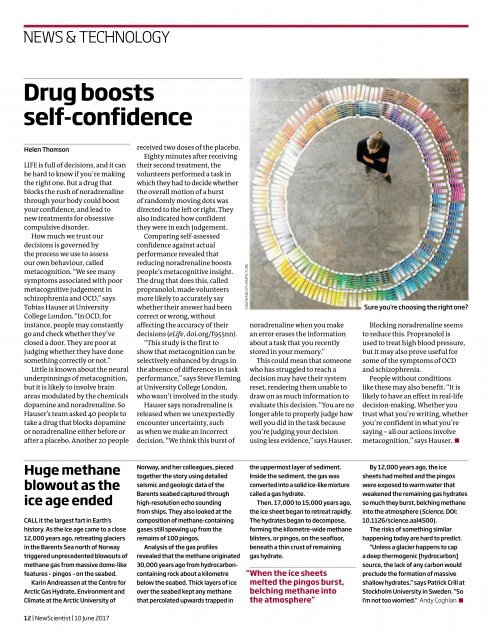New Scientist – June 10 2017
You also want an ePaper? Increase the reach of your titles
YUMPU automatically turns print PDFs into web optimized ePapers that Google loves.
NEWS & TECHNOLOGY<br />
Drug boosts<br />
self-confidence<br />
Helen Thomson<br />
LIFE is full of decisions, and it can<br />
be hard to know if you’re making<br />
the right one. But a drug that<br />
blocks the rush of noradrenaline<br />
through your body could boost<br />
your confidence, and lead to<br />
new treatments for obsessive<br />
compulsive disorder.<br />
How much we trust our<br />
decisions is governed by<br />
the process we use to assess<br />
our own behaviour, called<br />
metacognition. “We see many<br />
symptoms associated with poor<br />
metacognitive judgement in<br />
schizophrenia and OCD,” says<br />
Tobias Hauser at University<br />
College London. “In OCD, for<br />
instance, people may constantly<br />
go and check whether they’ve<br />
closed a door. They are poor at<br />
judging whether they have done<br />
something correctly or not.”<br />
Little is known about the neural<br />
underpinnings of metacognition,<br />
but it is likely to involve brain<br />
areas modulated by the chemicals<br />
dopamine and noradrenaline. So<br />
Hauser’s team asked 40 people to<br />
take a drug that blocks dopamine<br />
or noradrenaline either before or<br />
after a placebo. Another 20 people<br />
received two doses of the placebo.<br />
Eighty minutes after receiving<br />
their second treatment, the<br />
volunteers performed a task in<br />
which they had to decide whether<br />
the overall motion of a burst<br />
of randomly moving dots was<br />
directed to the left or right. They<br />
also indicated how confident<br />
they were in each judgement.<br />
Comparing self-assessed<br />
confidence against actual<br />
performance revealed that<br />
reducing noradrenaline boosts<br />
people’s metacognitive insight.<br />
The drug that does this, called<br />
propranolol, made volunteers<br />
more likely to accurately say<br />
whether their answer had been<br />
correct or wrong, without<br />
affecting the accuracy of their<br />
decisions (eLife, doi.org/f955nn).<br />
“This study is the first to<br />
show that metacognition can be<br />
selectively enhanced by drugs in<br />
the absence of differences in task<br />
performance,” says Steve Fleming<br />
at University College London,<br />
who wasn’t involved in the study.<br />
Hauser says noradrenaline is<br />
released when we unexpectedly<br />
encounter uncertainty, such<br />
as when we make an incorrect<br />
decision. “We think this burst of<br />
SUEDHANG/PLAINPICTURE<br />
noradrenaline when you make<br />
an error erases the information<br />
about a task that you recently<br />
stored in your memory.”<br />
This could mean that someone<br />
who has struggled to reach a<br />
decision may have their system<br />
reset, rendering them unable to<br />
draw on as much information to<br />
evaluate this decision. “You are no<br />
longer able to properly judge how<br />
well you did in the task because<br />
you’re judging your decision<br />
using less evidence,” says Hauser.<br />
<strong>–</strong>Sure you’re choosing the right one?<strong>–</strong><br />
Blocking noradrenaline seems<br />
to reduce this. Propranolol is<br />
used to treat high blood pressure,<br />
but it may also prove useful for<br />
some of the symptoms of OCD<br />
and schizophrenia.<br />
People without conditions<br />
like these may also benefit. “It is<br />
likely to have an effect in real-life<br />
decision-making. Whether you<br />
trust what you’re writing, whether<br />
you’re confident in what you’re<br />
saying <strong>–</strong> all our actions involve<br />
metacognition,” says Hauser. ■<br />
Huge methane<br />
blowout as the<br />
ice age ended<br />
CALL it the largest fart in Earth’s<br />
history. As the ice age came to a close<br />
12,000 years ago, retreating glaciers<br />
in the Barents Sea north of Norway<br />
triggered unprecedented blowouts of<br />
methane gas from massive dome-like<br />
features <strong>–</strong> pingos <strong>–</strong> on the seabed.<br />
Karin Andreassen at the Centre for<br />
Arctic Gas Hydrate, Environment and<br />
Climate at the Arctic University of<br />
Norway, and her colleagues, pieced<br />
together the story using detailed<br />
seismic and geologic data of the<br />
Barents seabed captured through<br />
high-resolution echo sounding<br />
from ships. They also looked at the<br />
composition of methane-containing<br />
gases still spewing up from the<br />
remains of <strong>10</strong>0 pingos.<br />
Analysis of the gas profiles<br />
revealed that the methane originated<br />
30,000 years ago from hydrocarboncontaining<br />
rock about a kilometre<br />
below the seabed. Thick layers of ice<br />
over the seabed kept any methane<br />
that percolated upwards trapped in<br />
the uppermost layer of sediment.<br />
Inside the sediment, the gas was<br />
converted into a solid ice-like mixture<br />
called a gas hydrate.<br />
Then, 17,000 to 15,000 years ago,<br />
the ice sheet began to retreat rapidly.<br />
The hydrates began to decompose,<br />
forming the kilometre-wide methane<br />
blisters, or pingos, on the seafloor,<br />
beneath a thin crust of remaining<br />
gas hydrate.<br />
“When the ice sheets<br />
melted the pingos burst,<br />
belching methane into<br />
the atmosphere”<br />
By 12,000 years ago, the ice<br />
sheets had melted and the pingos<br />
were exposed to warm water that<br />
weakened the remaining gas hydrates<br />
so much they burst, belching methane<br />
into the atmosphere (Science, DOI:<br />
<strong>10</strong>.1126/science.aal4500).<br />
The risks of something similar<br />
happening today are hard to predict.<br />
“Unless a glacier happens to cap<br />
a deep thermogenic [hydrocarbon]<br />
source, the lack of any carbon would<br />
preclude the formation of massive<br />
shallow hydrates,” says Patrick Crill at<br />
Stockholm University in Sweden. “So<br />
I’m not too worried.” Andy Coghlan ■<br />
12|<strong>New</strong><strong>Scientist</strong>|<strong>10</strong><strong>June</strong><strong>2017</strong>


















